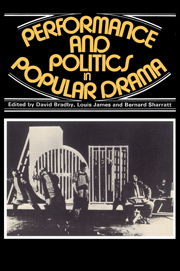 Performance and Politics in Popular Drama
Performance and Politics in Popular Drama Book contents
- Frontmatter
- Contents
- List of contributors
- Preface
- Acknowledgements
- PART ONE Spectacle, performance and audience in nineteenth-century theatre
- PART TWO Politics and performance in twentieth-century drama and film
- Introduction
- Meyerhold and Eisenstein
- Erwin Piscator's 1927 production of Hoppla, We're Alive
- Prolet Buehne: agit-prop in America
- Workers' theatre 1926–36
- The October Group and theatre under the Front Populaire
- Only the stars survive: disaster movies in the seventies
- PART THREE Problems and prospects
- Appendix: Tempo, Tempo
- Select bibliography
- General index
- Index of titles of plays, films, sketches
- Index of theatres, theatre companies and groups
Erwin Piscator's 1927 production of Hoppla, We're Alive
Published online by Cambridge University Press: 08 March 2010
- Frontmatter
- Contents
- List of contributors
- Preface
- Acknowledgements
- PART ONE Spectacle, performance and audience in nineteenth-century theatre
- PART TWO Politics and performance in twentieth-century drama and film
- Introduction
- Meyerhold and Eisenstein
- Erwin Piscator's 1927 production of Hoppla, We're Alive
- Prolet Buehne: agit-prop in America
- Workers' theatre 1926–36
- The October Group and theatre under the Front Populaire
- Only the stars survive: disaster movies in the seventies
- PART THREE Problems and prospects
- Appendix: Tempo, Tempo
- Select bibliography
- General index
- Index of titles of plays, films, sketches
- Index of theatres, theatre companies and groups
Summary
Erwin Piscator would probably have disliked the term ‘popular theatre’ – at least in its most obvious German version, ‘Volksdrama’ or ‘Volkstheater’. As a director whose ambition was to create a revolutionary, class-conscious theatre which aimed at ‘agitation with scenic means’, these expressions would have had an innocuous and anachronistic ring. The Berlin Volksbuhne, for instance, founded in 1890 to bring serious drama within the reach of the working masses, had ceased by the 1920s to reflect their political and social interests and, as Piscator put it, ‘had lost its last vestige of aggressiveness and been swallowed up and absorbed into the sphere of the bourgeois theatre’. Piscator's own early experiments led him to realise that any hope of building up a truly proletarian theatre movement was not possible in a society devoid of the necessary political and economic prerequisites. After some half dozen productions mounted between 1920 and 1921 in various assembly halls and workers' pubs in Berlin, he was forced to develop his ideas within the framework of the conventional theatre, including the Volksbuhne about which he had been so disparging. Three politically tendentious productions there between 1924 and 1927 led to a clash with the management who objected to the word ‘Volk’ in the name of their institution being equated with the ‘radical working classes’. Piscator was obliged to look around for an alternative home for his dramaturgical ideas and, thanks to the wealthy connections of the actress Tilla Durieux, was able to take over the Theater am Nollendorfplatz.
- Type
- Chapter
- Information
- Performance and Politics in Popular DramaAspects of Popular Entertainment in Theatre, Film and Television, 1800–1976, pp. 189 - 200Publisher: Cambridge University PressPrint publication year: 1980


